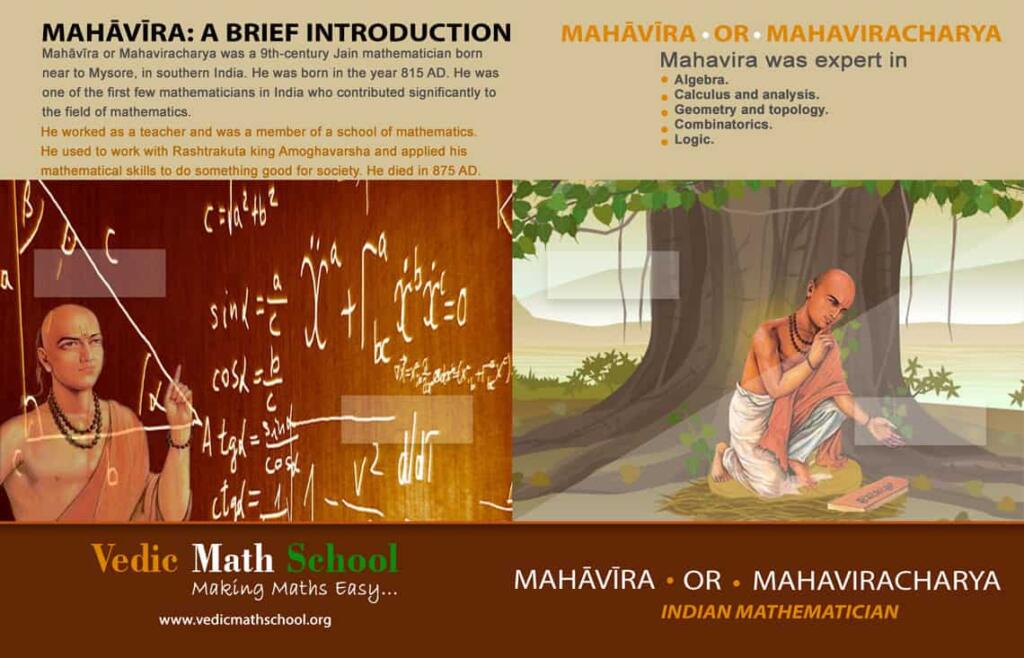Mahaviracharya – Great Indian Mathematician
Mahavira Jain, also known as Mahaviracharya, was an Indian mathematician born in the 9th century, possibly in or close to the present day city of Mysore. He is widely considered to be a prominent Indian mathematician, who made many significant contributions to the development of algebra.
He is believed to have taken his name of ‘Jain’ to honour the great Jainism reformer Mahavira. He is also well known as the author of ‘Gaṇitasārasan̄graha’ (Ganita Sara Sangraha) or the Compendium on the gist of Mathematics in 850, during the reign of Amoghavarsha (c. 814–878) of the Rashtrakuta dynasty. Gaṇitasārasan̄graha comprises more than 1130 versified rules and examples divided in nine chapters: the 1st chapter for ‘terminology’, and the rest for ‘mathematical procedures’ such as basic operations, problems involving a linear or quadratic equations, reductions of fractions, mixture problems, the rule of three, ditches (solids), shadows (similar right-angled triangles) and geometric computations with plane figures,
Mahaviracharya Contribution in Maths
Mahavira or Mahaviracharya (c. 9th century AD, 800-870 AD) was a Jain mathematician who made significant contributions to the development of algebra in what is now the city of Mysore, South India. Many Indian mathematicians at the time of Mahavira did their work in mathematics, but also included texts in which other topics such as astronomy were discussed.
Mahavira or Mahaviracharya Mahavira was a teacher and Jain mathematician of the 9th century who was born in the current city of Mysore in southern India. The Ganita Sara Samgrahaby of Mahaviracharya is the earliest Indian text they have dedicated to mathematics. In the introduction to the book he gives tribute to mathematicians whose work formed the basis for his work. Mahavira Jain, also known as Mahavaracharya, was an Indian mathematician born in the 9th century in the Indian state of Karnataka.
One of the most respected Jain mathematicians and monks, Mahaviracharya Ganita wrote Sara Samgraha around 850 AD during the reign of the great Rashtrakuta king Amoghavarsha. The formulation is a clear indication of his place of origin in the value-number system. Among the topics discussed by Mahavira in this paper are the operations of fractions, including methods for breaking integers into fractions and units of fractions. Solutions to positive integers are many times smaller than they are, he claims. Mahavira also gives special rules for the use of permutations and combinations, subjects of particular interest in Jaina mathematics.
Many renowned Indian mathematicians such as Aryabhata, Shakuntala Devi, Srinivas Ramanujan, Madhava Sangamagrama enlightened the world with their work, but this book not only provides insights into the history of Indian mathematics, but also a lot about Vedic mathematics. The rules and consequences of the general square root rule can be found in the Indian mathematical works of Aryabhata.
Read More : Yashwantrao Holkar: The Maratha King who single handedly shook British Camps in the 19th century
Mahaviracharya was one of the most brilliant mathematicians of the Vedic era
He was one of the first mathematicians from India to make a contribution to mathematics. He developed formulas for approximating the area and circumference of ellipses and found a method for calculating the number square and the cube root from numbers. His importance extended beyond southern India, and his work proved inspiring to other mathematicians in the region.
He used the work of Rashtrakuta and King Amoghavarsha to use his mathematical skills for the benefit of society. This paper is a brief description of mathematics and astronomy developed by Indian mathematicians of the time. The early texts contain rules and results for a number of problems and are full of edited mathematical arguments.
Mahaviracharya takes its name in honor of the great Jainism reformer Mahavira. He is the first to mention that the real square root of a negative number exists. The subject of interest on this CD is his work on the history of Indian mathematics.
On another occasion, Professor Subhash Kak of Louisiana State University in Baton Rouge emphasized that he presents Indian works uniquely and is known to the today interested community of mathematicians interested in history of mathematics. Mahaviracharya was one of the most brilliant mathematicians of the Vedic era. He was a Jain and is believed to have taken his name from the Jains in honor of Mahavira’s great Jainism reformer.
He has also given many types of triangles in his treatise. The method of finding the area of isosceles triangle, scalene triangle, rectangle, rhombus, quadrilateral, circle and five faces is mentioned.
Mahaviracharya has also propounded many principles related to algebra in his book ‘Genet-Saar-Sarah’. In this, he has described many such rules related to finding the principal amount, interest, amount and time and the remaining basic part related to it, which is very important in ancient times and modern mathematics.
Combination of Fractions
When the result is 1, then fractions of 1 degree, whose denominators start with 1 and are multiplied by 3 respectively. The first and last will be multiplied by (respectively) 2 and 2/3.
Equations of higher order
Mahavir presented the solution of the following types of equations of n degree and higher order. The name of the second chapter of the Ganitsaarsangraha is Kala-Savarna-Varana (the operation of the reduction of fractions).
Formula of cyclic quadrilateral
Aditya and his predecessor Brahmagupta had highlighted the merits of cyclic quadrilaterals. After this, Mahavira gave equations to find the length of the sides and diagonals of cyclic quadrilaterals.
Major Functions at a Glance
Presented the general formula for the number of permutations and accumulations.
Present the solutions of n-degree equations.
Published several characteristics of a cyclic quadrilateral.
He said that negative numbers cannot have a square root.
Find the sum of the n-terms of the class containing the square of the terms of the A.P.
Presented the empirical formula for the circumference and area of an ellipse.
Read More : 11 Mind Blowing Facts about Maharana Pratap Singh
